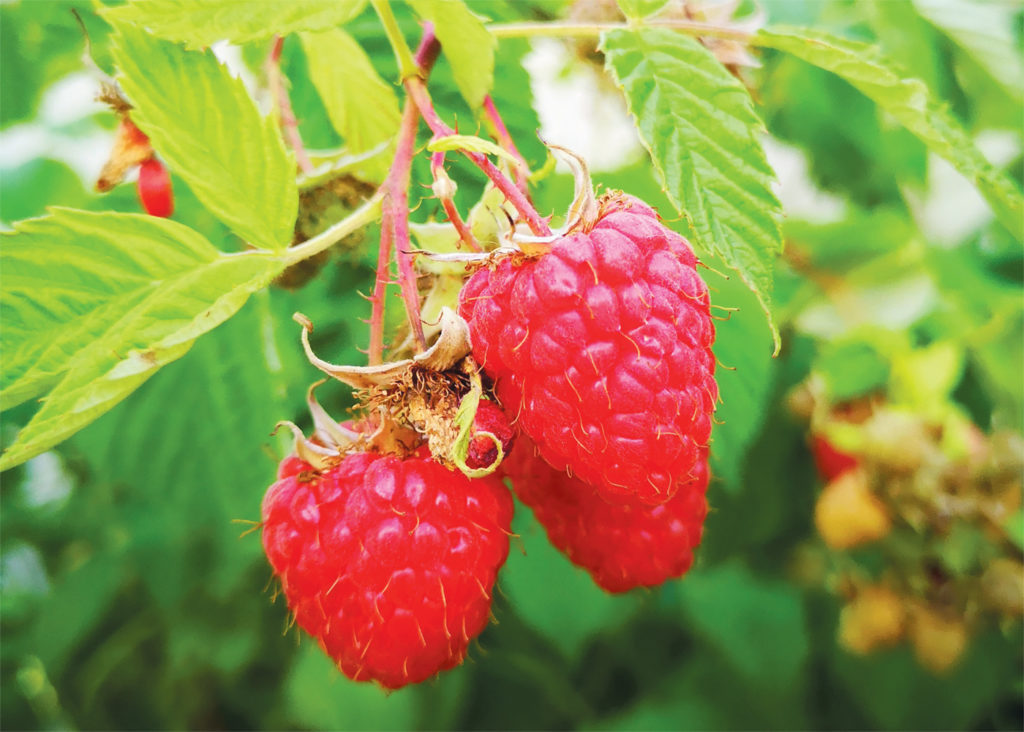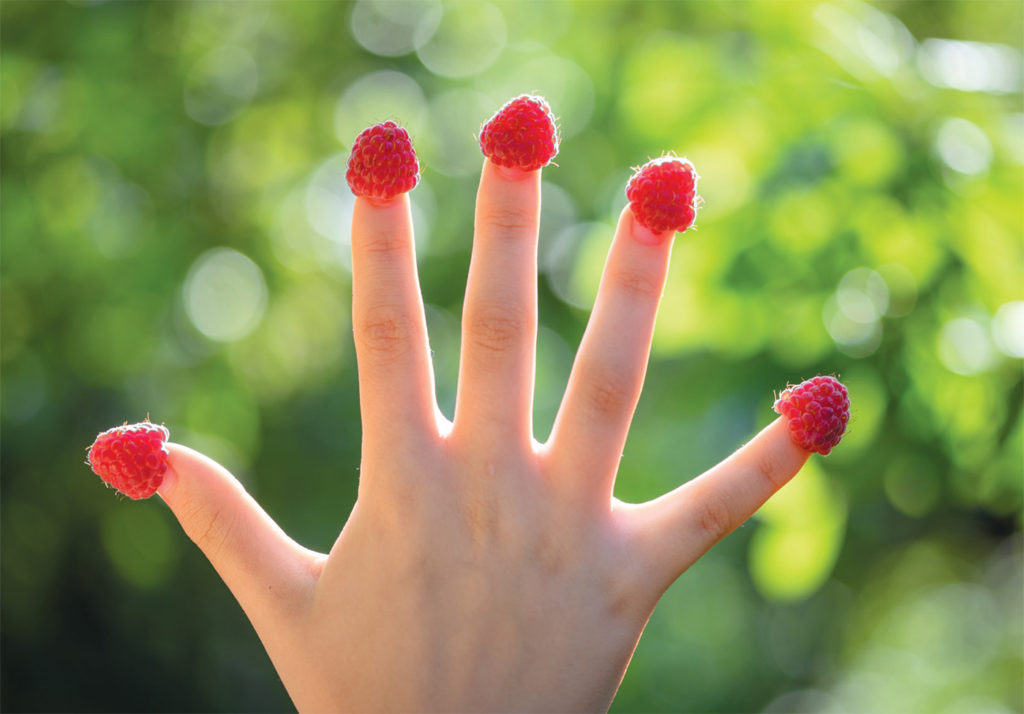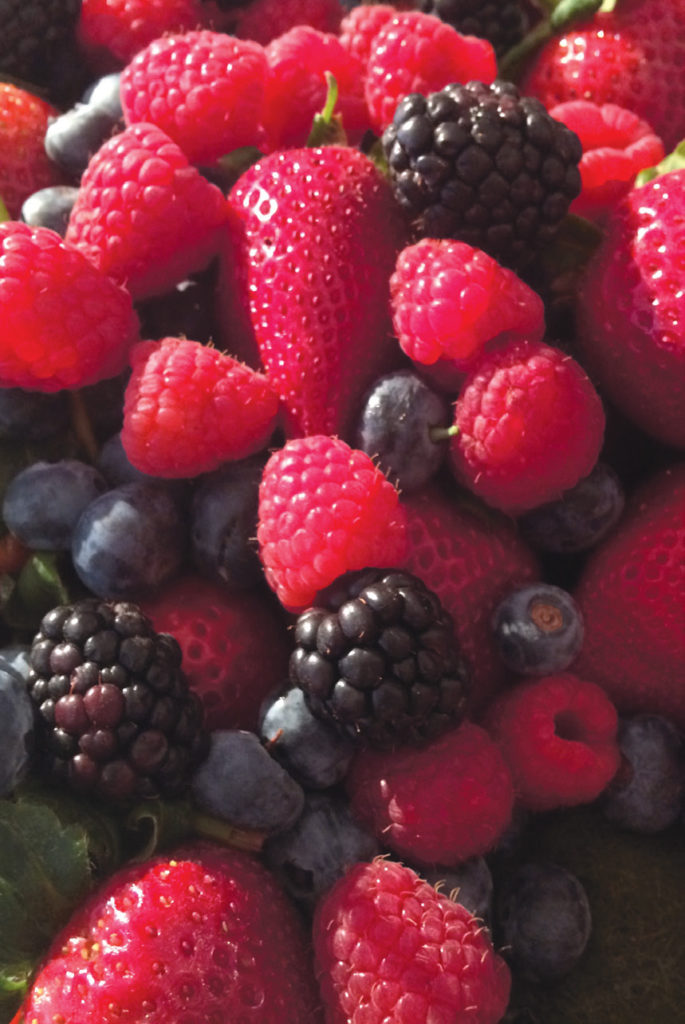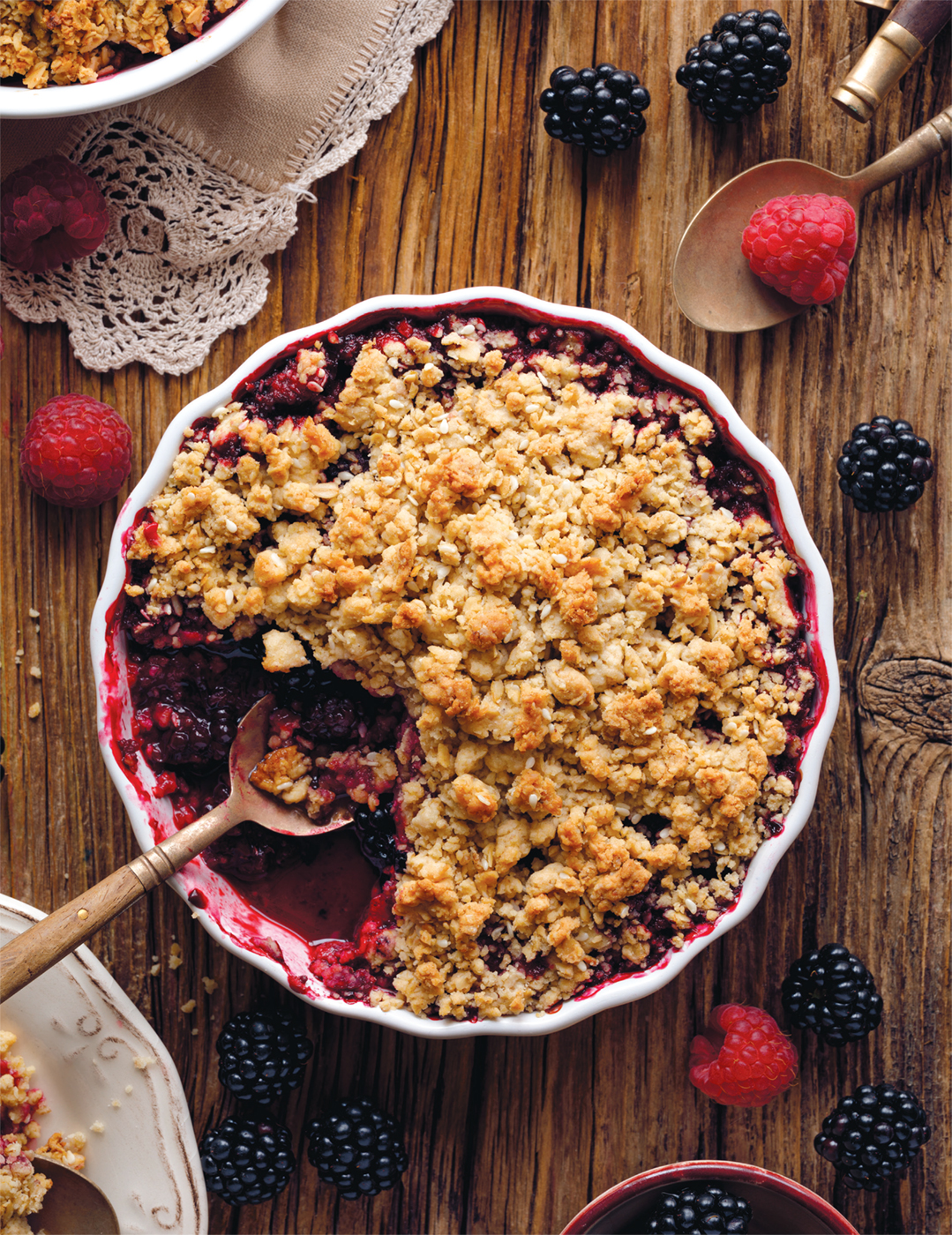
A razzle dazzle taste of summer
Raspberries remind me of my aunt, who would bring a big bowl of summer fruits with her when she visited, because she knew I preferred berries to sweets. Whenever raspberries were in the bowl, I’d put them on the tips of my fingers before I ate them. My son Ivan is now the fruit bat of the family, and I’ve caught him doing the same thing.
Raspberries—botanically known as Rubus idaeobatus— are perennial cane berries in the rose family. Their name comes from the 15th century word raspise which meant “sweet, rose colored wine.” When you eat a raspberry off the vine you pull the fruit from the center etaerio (the part that connects the fruits like an inner stem) and it stays attached to the plant; that’s the reason kids can stick their fingers in them! Because of this, raspberries are softer and more delicate than blackberries. When you eat a raspberry you are ingesting a hundred or more individual drupelets, the scientific word for tiny aggregate fruits that contain edible seeds.

NATIVE ROOTS
Raspberries originated in Asia and North America, and there are records of these jammy jewels being wild foraged in the foothills of Turkey prior to the fourth century. A Roman agronomist documented that they were domesticated and found in gardens just after that time, and seeds were found at Roman forts in Britain, indicating that the Romans were responsible for the spread of cultivation throughout Europe. Before this time raspberries were only eaten by royalty and used as pigment, to add juicy red color to paintings and manuscripts.
When European settlers arrived in America they found Native Americans were already eating and storing wild raspberries as a food source, and using the parts of the plant for medicine. The leaves, bark and roots were valued for various digestive ailments. Indigenous peoples in the Pacific Northwest, Canada and Alaska called them salmonberries because the tribes enjoyed them alongside salmon roe, quite the nutrient dense combination. They also made drinks out of raspberries and added them to meat dishes and soups. They were considered such an important source of nutrients that raspberries were dried and pressed into thick cakes with dried buffalo meat and tallow. These original protein bars, called pemmican, were very nutrient dense and high in calories, and could provide sustenance through lean winter months or long distance travel. Pemmican did not spoil because the meat and raspberries were preserved in fat.
LOCAL FAVORITE
These days the West Coast is the largest producer of red raspberries. Washington leads with 70% of the production in frozen and processed fruit, followed by Oregon and California, which grow mainly for the fresh market. There are currently 10,000 acres in production in California. Acreage has been slowly increasing in Santa Cruz and Monterey counties where the strawberry market has become saturated. Raspberries are now the second most valuable crop in Santa Cruz County and third most important fruit crop in Monterey County, after strawberries and wine grapes. The Monterey Bay area is a perfect place for growing fresh market raspberries practically year-round due to rich soil, plenty of sun and very little precipitation that can ruin the fruit. A good crop can yield 4,000 pounds to the acre each season, and the plants can be left in the ground for several years, unlike strawberries that are re-planted annually.
Raspberries can be found locally starting in mid-April through November. Varieties that ripen at different times are grown, but the best tasting raspberries are those harvested in the summer when the sun boosts sugar content.
Javier Zamora, owner of JSM Organics, tends 12 acres of raspberries in Watsonville. He grows four varieties of red raspberries as well as Anne (yellow) and double gold (blushyorange). His favorite to snack on is Anne because they are very fragrant and sweet with a hint of a tropical fruit taste. He says the double gold are less sweet than Anne but have a mango essence to them. You can buy his raspberries at the Thursday downtown Carmel Farmers Market and by U-Pick with an appointment during the months of June, July and August when the fruit is most abundant.
Prevedelli Farms and JCG Farms both also grow organic raspberries in Watsonville. Prevedelli can be found at the Downtown Santa Cruz Farmers Market on Wednesdays with raspberries, blackberries, ollalieberries and boysenberries.
In Carmel, Earthbound Farm was founded as a 2.5-acre organic raspberry farm in the 1980s and still has rows of raspberries to visit behind the farm stand on Carmel Valley Road.

HOW TO GROW
New cultivars have come out that have stronger canes and need less staking, and some new varieties are even thornless, so be sure to look for those varieties when considering planting raspberries in the garden. Bees will help pollinate the raspberries and love the nectar the raspberry flowers produce, so there are dual benefits to growing them in the garden. They can be grown from a cutting, a plug plant or by digging up suckers that pop up next to the mother plant.
The best time to plant is late fall to early spring. Make sure to locate a spot with full sun and nice soil that has been worked well and has no hard areas where roots will struggle to spread. Each plant should be spaced 24 inches apart with 3 feet between rows. When planting canes, be sure that the hole is wide enough to accommodate all of the roots when they are spread out, however the main roots only need to be 2 inches below the ground. Cover well with soil and top with compost. Water often to establish the root system. Once the canes start leafing out, apply a slow release organic fertilizer that is high in nitrogen, and when the flowers and fruit start, apply some fish or kelpbased fertilizer, calcium and potassium.
Be sure to harvest all the raspberries, even the bad ones, and remove them from the area to avoid fruit flies that can lay their eggs inside the berries and ruin all the upcoming fruit. Mites can also be problematic; the best thing to do is prevent them by reducing dust in the growing area and keeping the plants healthy and strong. The closer you are to the coast, the more issues you might have with fungus from the evening mist that occurs and can rot ripe fruit. If this is an issue, covering with plastic hoops will protect the plants.
GOOD EATING
Like most fruits, raspberries are mostly water, but due to their tiny seeds, the fiber content is one of the highest in any fruit or vegetable at 6% per weight. They are low in sugar, high in vitamin C and manganese, and contain anthocyanins and carotenoids—both antioxidants which combat free radicals in the body that can cause disease.
I love to make raspberry leaf tea for both the health benefits and the flavor, which is similar to black tea. Red raspberry leaf tea is good for pregnancy and labor—it helps to induce labor and boost milk supply. The leaves are delicious hot or cold and combined with other herbs or fresh raspberries.
Raspberries add intense flavor to beverages, salad dressings and alcoholic beverages such as framboise, a Belgian lambic fruit beer, and Chambord, a French raspberry liqueur.
Chambord was inspired by a liqueur made in France that was given to Louis XIV during a fancy meal during his visit to Château de Chambord in Loire Valley, France. It is made by infusing red and black raspberries in spirits for several weeks. Then fresh berry juice is pressed and combined with the infused spirit and vanilla, citrus peel, honey, herbs and cognac.
You can simply pop some raspberries in vodka or any other clear spirit to get a flavored, yet lighter raspberry-infused alcohol. Of course you don’t need alcohol to enjoy an infused drink with raspberries. I like to pair thyme with raspberries and make lemon or limeade. To do so, make simple syrup using equal parts water and white sugar, add the thyme once boiling, turn down the heat to simmer and let it infuse for 20 minutes then strain. In a separate pot, cook raspberries in a little water to cover them until they juice out to a liquid. Let cool. Next, add the juice of a few Meyer lemons or limes, add a splash of thyme simple syrup with the raspberry juice. Add the syrup slowly until you reach the desired sweetness. If you want it tarter, add more citrus juice. Pour over ice, or better yet, make popsicles and add some whole fresh fruit to them. You can also add whole raspberries to rosé and make wine pops!

Summer Berry Crisp
The subtle citrus notes in the filling of this simple homestyle favorite make the berry flavors sparkle. Blueberries hold their shape and strawberries are naturally sweet, but any combination of berries works. This crisp really doesn’t need adornment, but if you can’t resist, a dollop of crème fraîche adds a pleasant tart contrast to the sweet fruit. And of course, whipped cream or ice cream are also delicious!
About the author
Jamie Collins is the owner of Serendipity Farms and has been growing organic row crops at the mouth of Carmel Valley since 2001. She distributes her produce through a CSA, u-picks and farmers’ markets.
-
Jamie Collinshttps://www.ediblemontereybay.com/author/jcollins/
-
Jamie Collinshttps://www.ediblemontereybay.com/author/jcollins/
-
Jamie Collinshttps://www.ediblemontereybay.com/author/jcollins/
-
Jamie Collinshttps://www.ediblemontereybay.com/author/jcollins/


